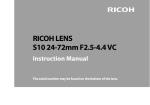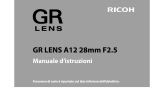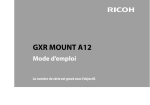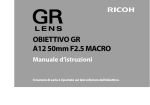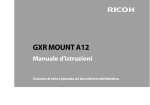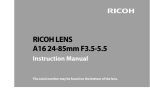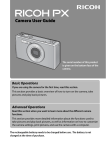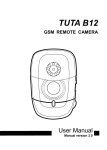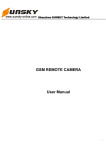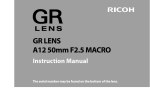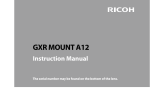Download Ricoh P10 28-300mm F3.5-5.6 VC Instruction manual
Transcript
RICOH LENS P10 28-300mm F3.5-5.6 VC* Instruction Manual The serial number may be found on the bottom of the lens. * VC indicates that this unit features Ricoh’s original Vibration Correction image stabilization technology. Package Contents Before using your Ricoh lens, confirm that the package contains the items listed below. Camera unit Lens cap The serial number may be found on the bottom. Comes attached to the camera unit. Instruction manual (this manual) Warranty Connector cap Comes attached to the camera unit. Soft case Introduction To use this lens, you need to attach it to a compatible camera body. Refer to the Camera Body User Guide for details about how to operate shooting and playback functions and change settings and to read important precautions for use. This instruction manual will refer to this lens as the “camera unit” and will explain functions and operating procedures that are available only when this camera unit is used with a compatible camera body. See also the GXR Camera Body User Guide. To make the best use of this product’s functions, read this manual thoroughly before use. Please keep this manual handy for ease of reference. Ricoh Co., Ltd. Safety precautions Test shots Copyright Exemption from liability Warranty Radio interference Read all safety precautions thoroughly to ensure safe use. Take test shots to ensure that the camera is working properly before taking photos on important occasions. Reproduction or alteration of copyrighted documents, magazines, and other materials, other than for personal, home, or other similarly limited purposes, without the consent of the copyright holder, is prohibited. Ricoh Co., Ltd. assumes no liability for failure to record or display images as a result of product malfunction. The warranty supplied with this product is only valid within the country of purchase. The manufacturer assumes no responsibility for servicing the product in other countries or bearing any expense thereby incurred. Operating this product in the vicinity of other electronic equipment may adversely affect both the camera and the other device. Interference is particularly likely if the camera is used in close proximity to a radio or television. This can be resolved by moving the camera as far as possible from the other device, reorienting the radio or television antenna, or plugging the radio or television into a different outlet. © 2010 RICOH CO., LTD. All rights reserved. This publication may not be reproduced in whole or in part without Ricoh’s express written permission. Ricoh reserves the right to change the contents of this document at any time without prior notice. Every effort has been made to ensure the accuracy of the information in this document. Should you nevertheless notice any errors or omissions, we would be grateful if you would notify us at the address listed on the back cover of this booklet. Safety Precautions Warning Symbols Various symbols are used throughout this instruction manual and on the product to prevent physical harm to you or other people and damage to property. The symbols and their meanings are explained below. Danger This symbol indicates matters that may lead to imminent risk of death or serious injury if ignored or incorrectly handled. Warning This symbol indicates matters that may lead to death or serious injury if ignored or incorrectly handled. Caution This symbol indicates matters that may lead to injury or physical damage if ignored or incorrectly handled. Sample Warnings The symbol alerts you to actions that must be performed. The symbol alerts you to prohibited actions. The symbol may be combined with other symbols to indicate that a specific action is prohibited. Examples = Do not touch = Do not disassemble Observe the following precautions to ensure safe use of this unit. Danger Do not attempt to disassemble, repair or alter the equipment yourself. The highvoltage circuitry in the equipment poses significant electrical hazard. Warning Keep the equipment out of the reach of children. Do not touch the internal components of the equipment if they become exposed as a result of being dropped or damaged. The high-voltage circuitry in the equipment could lead to an electric shock. Remove the battery as soon as possible, being careful to avoid electric shocks or burns. Take the equipment to your nearest dealer or service center if it is damaged. Do not use the equipment in wet areas as this could result in fire or electric shock. Do not use the equipment near flammable gases, gasoline, benzene, thinner or similar substances to avoid the risk of explosion, fire or burns. • Do not use the equipment in locations where usage is restricted or prohibited as this may lead to disasters or accidents. Caution Do not allow the equipment to get wet. In addition, do not operate it with wet hands. Both pose the risk of electric shock. Safety Precautions for Accessories When using optional products, carefully read the instructions provided with the product before using that product. Table of Contents Package Contents.................................................................................................. 2 Introduction........................................................................................................... 3 Safety Precautions................................................................................................. 6 Parts of the Lens..................................................................................................13 Upgrading the Product......................................................................................14 Updating the camera’s firmware....................................................................................14 Up-down dial........................................................................................................17 Additional Function for Up-down Dial........................................................................17 Shooting................................................................................................................18 Mode P: Program Shift.......................................................................................................18 A: Aperture Priority Mode.................................................................................................20 S: Shutter Priority Mode....................................................................................................20 10 Mode M: Manual Exposure...............................................................................................21 The Zoom Macro Scene Mode........................................................................................22 Dynamic Range Double Shot Mode.............................................................................23 Multi-Target AF.....................................................................................................................27 M-Cont Plus (Low)...............................................................................................................29 M-Cont Plus (Hi)...................................................................................................................31 Speed Cont (Low)/Speed Cont (High)..........................................................................32 Focus bracketing..................................................................................................................33 [Noise Reduction] Setting................................................................................................36 White balance setting........................................................................................................37 Playback................................................................................................................38 Camera Unit Information Display..................................................................................38 Settings.................................................................................................................39 Shooting Menu Settings in [Zoom Macro] Mode....................................................39 Shooting Menu Settings in [Dynamic Range] Mode..............................................41 [Picture Quality/Size] Setting (Shooting Menu).......................................................42 11 [ISO Setting] Setting (Shooting Menu)........................................................................45 [Camera Shake Correction] Setting (Shooting Menu)............................................46 [Reg. My Settings] (Key Custom Setting Tab)............................................................46 [Set Fn1 Button]/[Set Fn2 Button] (Key Custom Setting Tab)..............................47 [ADJ Lever Setting] (Key Custom Settings Tab).........................................................47 [ADJ. Direct ISO Control] Setting (Key Custom Setting Tab)................................48 [Digital Zoom Image] Setting (Setup Tab)..................................................................49 [Step Zoom] Setting (Setup Tab)....................................................................................49 Specifications.......................................................................................................50 Internal Memory/Memory Card Capacity...................................................................56 Appendices...........................................................................................................59 Optional Accessories..........................................................................................................59 Precautions for Use.............................................................................................................61 Equipment Care and Storage..........................................................................................62 Warranty and Servicing.....................................................................................................63 12 Parts of the Lens 2 1 3 1 Connector 2 Ring cap 3 Lens 13 Upgrading the Product Updating the camera’s firmware When you first attach the camera unit to the camera body, the version update function will start automatically if the firmware of the camera’s body need to be updated. In such case, update the firmware of the camera’s body using the following procedure. If the firmware’s version is already up to date, the version update function will not start and you can use the lens right away. 1 Check that the camera is turned off and attach the camera unit to the camera body. • For details about how to attach the camera unit, refer to the Camera Body User Guide. 14 2 Turn on the camera. • A confirmation message about updating the firmware appears. 3 Press the Fn1/Fn2 buttons to select [Yes] and then press the MENU/ OK button. • The firmware’s update begins and the following messages appear on the picture display. [Checking rewrite file] [Rewriting program] The camera will automatically turn off and then back on. After the camera restarts, the firmware’s version screen will be displayed and the update will be completed. 15 Note--------------------------------------------------------------------------------------• To confirm the firmware’s version, select [Firmware Version] in the setup menu. Alternatively, with the camera off, keep the 6 (Play) button pressed for more than 1 second while holding the – button pressed down. The firmware’s version will appear on the picture display for about 20 seconds. • For the latest information on firmware updates, see the Ricoh Web site (http://www.ricoh.com/r_dc/). You can download the latest firmware updates to upgrade your equipment. 16 Up-down dial Additional Function for Up-down Dial When selecting the Flash mode, you can also use the Up-down Dial. When selecting the Self-Timer settings, you can also use the Up-down Dial. 17 Shooting Mode P: Program Shift Setting the mode dial to P (program shift mode) allows you to select a combination of aperture value and shutter speed. When the ISO setting is set to [Auto] or [Auto-Hi], the camera will adjust the ISO sensitivity automatically to obtain the optimal exposure. The diagram in the following page gives an approximated estimate of the shift range for various combinations of aperture values and shutter speeds. The shift range changes depending on the exposure value (EV). In this example, the flash mode is set to [Flash Off ], and the ISO setting is set to [ISO100]. For the largest aperture value, it is used together with the ND filter. In this case, the degree to which the background is blurred does not change. The degree of blurring is expressed as the aperture value (F value) even when an ND filter is used. 18 : Wide : Tele Ev9 Ev8 Ev10 Ev11 Ev12 Ev13 Ev14 Ev15 Ev16 Ev17 Ev18 Ev19 Ev7 F15.4 Ev6 F16 F11 Ev5 F7.0 Ev4 F5.6 Ev3 F3.5 F8 F5.6 F4 Ev2 F2.8 Ev1 F2 Ev0 F1.4 F1 2 1 1/2 1/4 1/8 1/15 1/30 1/60 1/125 1/250 1/500 1/1000 1/2000 1/4000 19 A: Aperture Priority Mode Setting the mode dial to A (aperture priority mode) allows you to manually set the aperture value. For the largest aperture value, it is used together with the ND filter. When an ND filter is used, the degree to which the background is blurred does not change. The number of available aperture stops varies depending on the position of the zoom (2 stops at wide-angle end, 3 stops at telephoto end). When the ISO setting is set to [Auto] or [Auto-Hi], the camera will adjust the ISO sensitivity automatically to obtain the optimal exposure. S: Shutter Priority Mode 20 Setting the mode dial to S (shutter priority mode) allows you to manually set the shutter speed. The camera will adjust the sensitivity in the range of ISO 100 to ISO 3200 to obtain the optimal exposure, regardless of the ISO sensitivity settings. For the largest aperture value, it is used together with the ND filter. When the [Shutter Speed Auto Shift] setting in the shooting menu is set to [On], the camera will automatically adjust the shutter speed to obtain the best exposure when it cannot be obtained using the shutter speed that was set manually. The [Shutter Speed Auto Shift] setting will not appear when the mode dial is set to a mode other than S. Mode M: Manual Exposure Setting the mode dial to M (manual exposure mode) allows you to manually set the aperture value and shutter speed separately. For the largest aperture value, it is used together with the ND filter. When an ND filter is used, the degree to which the background is blurred does not change. If [Auto] or [Auto-Hi] is selected for ISO Setting, ISO will be fixed at 100 while the camera is in manual exposure mode. If the shutter speed is set to 1 second or longer, the maximum ISO available is ISO400. The maximum shutter speed available is 30 seconds. 21 The Zoom Macro Scene Mode When the mode dial is set to SCENE, selecting the [Zoom Macro] mode will automatically optimize the zoom position, allowing you to shoot the subject at a larger size than with normal macro shooting. In zoom macro mode, the optical zoom cannot be used. For zoom shooting methods, refer to the “Camera Body User Guide”. Caution----------------------------------------------------------------------------------• You can shoot close-ups using the zoom macro within the following distances. Approx. 1 cm (from the front of the lens) 22 Shooting range: Approx. 19 × 14 mm (when digital zoom is not used) Shooting range: Approx. 4.8 × 3.6 mm (when 4.0× digital zoom is used) • When [Picture Quality/Size] is set to 4:3 for [L], you can also set [Digital Zoom Image] to [Auto Resize], and auto resize zoom will be activated. (GP. 47) Dynamic Range Double Shot Mode The “dynamic range” of a digital camera refers to the range of brightness that can be processed by the camera. When you select the [Dynamic Range] scene mode and shoot, the scene is reproduced with a smooth transition from the bright areas to the dark areas, allowing you to capture a more natural-looking image. With dynamic range double shot, two consecutive pictures are taken with different exposures and then the areas with the appropriate exposure are combined together. This mode uses a longer shooting Combined and Two consecutive time than other modes, so be shots saved careful of camera shake when taking pictures. The J symbol is displayed while you half-press the shutter release button. 23 Note--------------------------------------------------------------------------------------Even when the camera is attached to a tripod, it may move when you press the shutter release button. For maximum stability it is recommended to use the self timer or the CA-1 cable switch (sold separately). Caution----------------------------------------------------------------------------------• This function is not available when [Picture Quality/Size] is set to RAW mode. • When using this function, digital zoom will be turned off. • When using this function, the flash will be set to Flash Off. • Dynamic range double shot may not be effective if the shooting location is overly bright or dark. • [Multi] metering is recommended. • When shooting a fast-moving subject, the subject may be distorted in the recorded image. • Flicker from fluorescent lights may appear as horizontal bands. Fluorescent lighting may also affect colors and brightness. 24 Dynamic Range Expansion Effect The [Dynamic Range Expansion] option in the shooting menu offers five levels of dynamic range expansion: [Auto], [Very Weak], [Weak], [Medium], and [Strong]. The stronger the expansion effect, the wider the range of brightnesses processed by the camera. To change the setting, select the [Dynamic Range] scene mode and change the [Dynamic Range Expansion] setting in the shooting menu. After selecting any setting except [Auto], press the Fn2 button to display the [Dynamic Range Expansion Options] on the screen. Choose the tone range given priority for expanded dynamic range from [Highlights], [Shadows], and [Off ]. 25 Dynamic Range Expansion Plus Normal Shooting When [On] is selected for [Plus Normal Shooting] in the shooting menu, the camera will record two copies of each photo: one with an expanded dynamic range and the other with normal exposure. The two copies are displayed in the picture display after shooting, with the unmodified copy on the right and the copy with an expanded dynamic range of the left. To change the setting, select the [Dynamic Range] scene mode and change the [Plus Normal Shooting] setting in the shooting menu. Note--------------------------------------------------------------------------------------Histograms of the images are displayed after shooting. When [LCD Confirmation Time] in the Setup tab is set to [Hold], the confirmation screen remains displayed so you can confirm the histograms and easily compare the images. 26 Multi-Target AF When you half-press the shutter release button, the camera automatically determines multiple focus positions. When you then press the shutter release button all the way down, the camera shifts among the different focus positions, taking five consecutive pictures. The five still images are grouped together as a set and are recorded as an MP file. This function is especially useful for telephoto shooting and shooting with macro mode. A green V icon will be displayed if the camera is able to focus. If the camera is unable to focus, the red V icon will blink. The focus positions selected by the camera are only displayed during playback. * MP is a file format for recording a set of still images. 27 Caution----------------------------------------------------------------------------------• The flash cannot be used. • The camera shake correction function cannot be used. If [Multi-trgt AF] is set while the camera shake correction function is turned on, E changes to F. • This function is not available when [Picture Quality/Size] is set to [RAW]. • When [Continuous Mode] is set to any setting except [Off ], you can change the Multi-target AF settings, but the function will not be used. • Interval shooting is not available when Multi-target AF is set. Note--------------------------------------------------------------------------------------• If this function is turned on when using the digital zoom, the digital zoom is disabled and shooting is performed at the maximum magnification for the optical zoom (10.7 ×). • [White Balance] functions according to the [Auto] setting even if it is set to [Multi-P AUTO]. 28 M-Cont Plus (Low) In this mode, the camera shoots while the shutter-release button is pressed, but only the last 15 frames (about the last three seconds of shooting) are recorded to create a single multi-picture (MP) file. 2 The camera records the 15 frames taken in the last 3 s of shooting. 1 8 9 3 2 10 11 5 4 12 13 6 14 7 15 1 When you remove your finger from the shutter release button... Caution----------------------------------------------------------------------------------The time needed to record 15 frames may increase if lighting is poor. 29 Note--------------------------------------------------------------------------------------• The image size is fixed at 3648 × 2736 NORMAL. • The date and orientation of each shot in the sequence are recorded separately. 30 M-Cont Plus (Hi) In this mode, the camera shoots while the shutter-release button is pressed, but only the last 26 frames (about the last 0.9 seconds of shooting) are recorded to create a single multi-picture (MP) file. 2 The camera records the 26 frames taken in the last 0.9 seconds of shooting. 1 19 20 3 2 21 22 5 4 23 24 6 25 7 26 1 When you remove your finger from the shutter release button... Caution----------------------------------------------------------------------------------When shooting a fast-moving subject, the subject may be distorted in the recorded image. 31 Note--------------------------------------------------------------------------------------• The image size is fixed at 1728 × 1296 NORMAL. • The date and orientation of the last shot in the sequence are also used for the remaining frames. Speed Cont (Low)/Speed Cont (High) 120 consecutive images are recorded in one second (Speed Cont (High)) or two seconds (Speed Cont (Low)). Caution----------------------------------------------------------------------------------When shooting a fast-moving subject, the subject may be distorted in the recorded image. 32 Note--------------------------------------------------------------------------------------• The image size is fixed at 640 × 480 VGA. • The date and orientation of the last shot in the sequence are also used for the remaining frames. Focus bracketing Focus bracketing is one of the functions available when using auto bracketing. Focus bracketing automatically shoots 5 consecutive shots while gradually changing the position of the focus. You can adjust the interval used to change the focus position. 1 Select [Auto Bracket] in the shooting menu and press the Fn2 button. 2 Press the +/- button to select [FOCUS-BKT] and press the Fn2 button. 33 3 Press the Fn1/Fn2 buttons to select the focus position interval and press the MENU/OK button. • The setting is saved, and the display returns to the shooting menu. 4 Press the MENU/OK button, or press the Fn1 button and then the MENU/OK button. • The symbol appears on the screen. 5 Half-press the shutter release button. • The camera focuses according to the [Focus] setting. 6 Press the shutter release button all the way down. • The camera takes five consecutive pictures based on the focus position in Step 5. Note--------------------------------------------------------------------------------------• When [Focus] is set to [MF], the first picture is taken at the set focus position without being measured. • [White Balance] functions according to the [Auto] setting even if it is set to [Multi-P AUTO]. 34 • Photographs are taken and recorded in the following order: Focus position Fore Center (*) Shooting order 2 3 1 4 1 2 3 4 Recording order Back 5 5 * Focus at the position set for the [Focus] setting in the shooting menu. • When using this function, the flash will be set to off. • When [Focus] is set to [Multi-trgt AF], you can change the focus bracketing settings but the function will not be used. • When [Picture Quality/Size] is set to [RAW], you can change the noise reduction setting but the function will not be used. • When [Continuous Mode] is set to any setting except [Off ], you can change the focus bracketing settings, but the function will not be used. 35 [Noise Reduction] Setting Perform noise reduction when taking photographs. Choose from [Off ], [Auto], [Weak], [Strong], or [MAX]. The time required to record images varies with the option selected. You can use this function to shoot photographs when the scene mode is set to a mode other than [Portrait], [Sports] or [Skew Correct Mode]. 36 White balance setting Using this lens you can set the white balance to [Incandescent 1] or [Incandescent 2]. Use the [Incandescent 1] or [Incandescent 2] setting when shooting under incandescent bulb light. Using [Incandescent 2] will leave a slightly redder tint, compared to [Incandescent 1]. Note--------------------------------------------------------------------------------------When using [Incandescent 2] you can shoot with the same color shades as with the [Incandescent] setting described in the Camera Body User Guide. 37 Playback Camera Unit Information Display Information of [A12], [S10] or [P10] for each camera unit is displayed on the Detailed Information Display and the Exif file. 38 Settings Shooting Menu Settings in [Zoom Macro] Mode When [Zoom Macro] is selected, items from the shooting menu that can be set and default values are as follows. Item Default setting Picture Quality/Size L 4:3 NORMAL Focus AF Pre-AF Off Exposure Metering Multi Image Settings Standard Continuous Mode Off Auto Bracket Off Flash Exposure Compensation 0.0 39 Item 40 Default setting Manual Flash Amount 1/2 Flash Synchro Settings 1st Curtain Noise Reduction Off Noise Reduction ISO Over ISO 401 Distortion Correction Off Custom Self-Timer 2 Pics, 5 seconds Date Imprint Off Exposure Compensation 0.0 White Balance Multi-P AUTO ISO Setting Auto Camera Shake Correction On Shooting Menu Settings in [Dynamic Range] Mode When [Dynamic Range] is selected, items from the shooting menu that can be set and default values are as follows. Item Picture Quality/Size Focus Snap Focus Distance Full Press Snap Pre-AF Exposure Metering Image Settings Noise Reduction Noise Reduction ISO Distortion Correction Default setting L 4:3 NORMAL Multi AF 2.5m On Off Multi Standard Off Over ISO 401 Off Custom Self-Timer Date Imprint 2 Pics, 5 seconds Off 41 Item Exposure Compensation White Balance White Balance Compensation ISO Setting Camera Shake Correction Dynamic Range Expansion Plus Normal Shooting Default setting 0.0 Multi-P AUTO A:0, G:0 Auto On Auto Off [Picture Quality/Size] Setting (Shooting Menu) The following picture quality, image size and aspect ratio options are available for the [Picture Quality/Size] setting in the shooting menu. A photograph‘s file size will depend on the combination of picture quality and image size used. When recording movies, you can select the movie size. 42 Photographs Item RAW L (Large) M (Middle) Aspect ratio Compression Image size (pixels) 16:9*2 FINE/NORMAL/VGA*1 3648 × 2048 4:3 FINE/NORMAL/VGA*1 3648 × 2736 2 3:2* FINE/NORMAL/VGA*1 3648 × 2432 1:1*3 FINE/NORMAL/VGA*1 2736 × 2736 16:9*2 FINE/NORMAL 3648 × 2048 4:3 FINE/NORMAL 3648 × 2736 3:2*2 FINE/NORMAL 3648 × 2432 1:1*3 FINE/NORMAL 2736 × 2736 16:9*2 FINE/NORMAL 3264 × 1840 4:3 FINE/NORMAL 3264 × 2448 3:2*2 FINE/NORMAL 3264 × 2176 1:1*3 FINE/NORMAL 2448 × 2448 43 Item Aspect ratio Compression Image size (pixels) 5M 4:3 FINE 2592 × 1944 3M 4:3 FINE 2048 × 1536 1M 4:3 FINE 1280 × 960 VGA 4:3 FINE 640 × 480 *1 When [RAW] is selected, this is the setting used for the JPEG copy. *2 Depending on the area photographed, black bands may appear on the top and bottom of the picture display. *3 Depending on the area photographed, black bands may appear at the right and left sides of the picture display. Movies Item 44 Movie size HD1280 1280 × 720 VGA640 640 × 480 QVGA320 320 × 240 [ISO Setting] Setting (Shooting Menu) When [Auto] is selected and the flash is not used, the range of the sensitivity used will be as follows. Picture size (pixels) Default Minimum Maximum RAW 100 100 200 L 100 100 200 M 100 100 200 5M 100 100 200 3M 100 100 200 1M 100 100 238 VGA 100 100 283 • When [Auto] is selected and the flash is used, the sensitivity used will gain up to ISO400 equivalent. 45 [Camera Shake Correction] Setting (Shooting Menu) When [Camera Shake Correction] is set to [On], the camera shake blurring is minimized. When camera shake correction is activated, the E symbol appears on the screen. [Reg. My Settings] (Key Custom Setting Tab) In [Reg. My Settings], you can also set [Step Zoom] and [Zoom Position] options in the setup tab. For other options available, refer to the “Camera Body User Guide”. 46 [Set Fn1 Button]/[Set Fn2 Button] (Key Custom Setting Tab) • [Step Zoom] and [AF/M-trgt AF] can be assigned to the Fn1/Fn2 buttons. • [AF/Snap], [WB Correction], [Step Zoom], and [AF/M-trgt AF] is not available by pressing the Fn1/Fn2 buttons if the scene mode is set to [Zoom Macro]. • When the scene mode is set to [Dynamic Range], the following functions will not be available even if you press the Fn1 or Fn2 button: [JPEG B RAW], [Continuous Mode], [Auto Bracket], [Flash Comp.], [Flash Amount], [Step Zoom] and [AF/M-trgt AF]. [ADJ Lever Setting] (Key Custom Settings Tab) When the scene mode is set to [Dynamic Range], the settings registered under [ADJ Lever Setting] are [Exposure Compensation] and [White Balance]. The available settings cannot be changed. 47 [ADJ. Direct ISO Control] Setting (Key Custom Setting Tab) When [ADJ. Direct ISO Control] in the Key Custom Settings tab is set to [On], you can push the ADJ. lever sideways when shooting is possible to change the ISO setting. The default setting at the time of purchase is [Off ]. Caution----------------------------------------------------------------------------------• The ADJ. lever can be used to adjust sensitivity while the shutter button is pressed halfway in program shift and aperture priority modes (in program shift mode, sensitivity can be adjusted even after the shutter button is released, as long as shutter speed and aperture are displayed). Note that once sensitivity has been adjusted in this manner, [Auto] and [Auto-Hi] can not be re-selected. • In shutter speed priority mode and manual exposure mode, you cannot use the ADJ. lever to change the ISO setting. 48 [Digital Zoom Image] Setting (Setup Tab) The size of the recorded image varies depending on the auto resize zoom, as follows. Zoom ratio Image size (pixels) Zoom ratio Image size (pixels) Approx. 1.0 × L Approx. 1.8 × 3M Approx. 1.1 × M Approx. 2.9 × 1M Approx. 1.4 × 5M Approx. 5.7 × VGA [Step Zoom] Setting (Setup Tab) If [Step Zoom] is set to [On], the focal length for zoom is fixed at eight steps (equivalent to 28 mm, 35 mm, 50 mm, 85 mm, 105 mm, 135 mm, 200 mm, and 300 mm*). * Equivalent to that on a 35-mm camera. 49 Specifications Specifications are given for the camera unit mounted on a GXR body. Effective pixels Approximately 10.0 million Image sensor 1/2.3" CMOS sensor (total pixels: approx. 10.6 million) Lens Focal length 4.9 mm to 52.5 mm (35-mm format equivalent: 28 mm to 300 mm) Aperture (f-number) f/3.5 – f/5.6 Focus range (from lens) Normal shooting: Approx. 30 cm to ∞ (wide angle); approx. 150 cm to ∞ (telephoto end) Macro shooting: Approx. 1 cm to ∞ (wide angle/zoom macro); approx. 27 cm to ∞ (telephoto end) Construction 50 10 elements in 7 groups (4 aspherical lens elements with 5 surfaces) Zoom 10.7 × optical zoom; 4.0 × digital zoom (2.8 × for movies, HD image); approx. 5.7 × auto resize zoom (VGA) Focus mode Multi AF; Spot AF; MF: Snap; ∞ ; Multi-trgt AF (AF auxiliary light and focus bracketing available) Shutter speed Exposure control Photographs 1/2000 – 30 s (upper and lower limits vary according to shooting and flash mode) Movies 1/30 – 1/2000 s Metering Multi metering (256-segment), center-weighted metering, spot metering (TTL metering, with AE lock) Mode Program AE, aperture priority AE, manual exposure, shutter priority AE, move target function Exposure compensation Manual (+4.0 to -4.0 EV in increments 1/3 EV or 1/2 EV), auto bracketing (-2 EV to +2 EV in increments 1/3 EV or 1/2 EV) Exposure link range (Auto shooting mode, Centerweighted light metering) Wide-angle end: 3.2 EV to 16.2 EV; Telephoto end: 4.6 EV to 18.4 EV (link range for automatic ISO converted based on the EV for ISO100) • When shooting in surroundings with 6.0 EV or lower, for every 1.0 EV that the exposure link range decreases, the camera will shift the setting 0.25 EV toward the low brightness side. The maximum shift amount is 1.0 EV. ISO sensitivity Auto, Auto-Hi, ISO 100, ISO 200, ISO 400, ISO 800, ISO 1600, (Standard Output Sensitivity) ISO 3200 51 White balance Auto, Multi-P AUTO, Outdoors, Cloudy, Incandescent 1, Incandescent 2, Fluorescent Lamp, Manual Settings, Detail; white balance bracketing Flash Approx. 0.2 m – 4.0 m (wide-angle), Approx. 0.27 m – 2.5 m (telephoto) Range (built-in flash) Shooting mode Auto, program shift, aperture priority, shutter priority, manual, scene (movie, portrait, sports, landscape, nightscape, skew correction, dynamic range double shot, zoom macro), “My Settings” Continuous Number of mode pictures shot in Continuous (Picture Size: RAW) Noise Reduction off: 5 pictures, Noise Reduction on (Weak, Strong or MAX): 4 pictures Number of pictures shot in M-Cont Plus (1 set) 52 Low (3648 × 2736) : 15 pictures (5 Frames/Sec), Hi (1728 × 1296) : 26 pictures (30 Frames/Sec) Continuous Number of mode pictures shot in Speed Cont (1 set) Low (640 × 480) : 120 pictures (60 Frames/Sec), Hi (640 × 480) : 120 pictures (120 Frames/Sec) Compression *1 FINE, NORMAL, RAW (DNG) *2 Image size (pixels) 3648 × 2048, 3648 × 2736, 3648 × 2432, 2736 × 2736, 3264 × 1840, 3264 × 2448, 3264 × 2176, 2448 × 2448, 2592 × 1944, 2048 × 1536, 1280 × 960, 640 × 480 Photographs Movies File size (approx.) RAW 1280 × 720, 640 × 480, 320 × 240 16:9 NORMAL: 13,053 KB/frame, FINE: 14,289 KB/frame, VGA: 11,477 KB/frame 4:3 NORMAL: 17,332 KB/frame, FINE: 18,984 KB/frame, VGA: 15,226 KB/frame 3:2 NORMAL: 15,440 KB/frame, FINE: 16,909 KB/frame, VGA: 13,568 KB/frame 1:1 NORMAL: 13,053 KB/frame, FINE: 14,292 KB/frame, VGA: 11,474 KB/frame 53 File size (approx.) L 16:9 NORMAL: 1,630 KB/frame, FINE: 2,779 KB/frame 4:3 NORMAL: 2,169 KB/frame, FINE: 3,705 KB/frame 3:2 NORMAL: 1,931 KB/frame, FINE: 3,295 KB/frame 1:1 NORMAL: 1,633 KB/frame, FINE: 2,785 KB/frame 16:9 NORMAL: 1,330 KB/frame, FINE: 2,254 KB/frame 4:3 NORMAL: 1,761 KB/frame, FINE: 2,990 KB/frame 3:2 NORMAL: 1,568 KB/frame, FINE: 2,660 KB/frame 1:1 NORMAL: 1,327 KB/frame, FINE: 2,249 KB/frame 5M 4:3 FINE: 2,288 KB/frame 3M 4:3 FINE: 1,474 KB/frame 1M 4:3 FINE: 813 KB/frame VGA 4:3 FINE: 197 KB/frame M 54 Battery life DB-90: approx. 440 shots *3 (based on CIPA standard) Dimensions (W × H × D) Camera unit only: 68.7 mm × 57.9 mm × 44 mm (Based on CIPA guide line) When mounted on the camera body: 113.9 mm × 70.2 mm × 49.8 mm (Based on CIPA guide line) Weight (approx.) Camera unit only: 160 g (not including the lens cap or connector cap) When mounted on the camera body: 367 g (including the lens cap, battery, and SD memory card) Operating temperature 0 °C to 40 °C Operating humidity 85% or less Storage temperature –20 °C to 60 °C *1 The options available vary with image size. *2 A JPEG file is also recorded (the JPEG file may be a FINE- or NORMAL-quality file with the dimensions as the RAW file or a VGA file 640 × 480 pixels in size). RAW files use the standard DNG format promoted by Adobe Systems, Inc. *3 For reference only; actual number of shots varies greatly according to how camera is used. We recommend that you carry spare batteries when in use for extended periods. 55 Internal Memory/Memory Card Capacity The following values are given as a reference of the storage capacity of the internal memory and memory cards of various sizes, by picture quality and image size, when using the FINE picture quality. Photographs 56 Compression Image size (pixels) 3648 × 2048 RAW* FINE 3648 × 2736 3648 × 2432 2736 × 2736 3648 × 2048 L FINE 3648 × 2736 3648 × 2432 2736 × 2736 3264 × 1840 M FINE 3264 × 2448 3264 × 2176 2448 × 2448 Internal memory 6 4 5 6 29 22 24 29 36 27 30 36 1 GB 2 GB 4 GB 8 GB 16 GB 32 GB 67 50 57 67 323 242 272 323 397 300 337 400 137 103 116 137 653 491 553 653 808 608 683 808 270 203 228 270 1284 965 1087 1284 1588 1195 1341 1588 551 415 466 551 2624 1973 2222 2624 3245 2442 2741 3245 1105 831 934 1105 5257 3953 4452 5257 6502 4893 5491 6502 2217 1688 1874 2217 10546 7930 8930 10546 13043 9815 11014 13043 Compression Image size (pixels) 5M FINE 2592 × 1944 3M FINE 2048 × 1536 1M FINE 1280 × 960 VGA FINE 640 × 480 Internal memory 34 53 96 395 1 GB 2 GB 4 GB 8 GB 16 GB 32 GB 373 581 1059 4316 758 1182 2118 8778 1490 2321 4160 17237 3045 4744 8505 35231 6101 9503 17039 70579 12238 19063 34181 141581 * When [RAW] is selected, this is the setting used for the JPEG copy. Continuous Mode Continuous Mode Image size (pixels) Internal 1 GB memory 2 GB 4 GB 8 GB 16 GB 32 GB M-Cont Plus (Low) 3648 × 2736 38 414 842 1653 3379 6769 13579 M-Cont Plus (High) 1728 × 1296 131 1438 2926 5746 11745 23530 47202 Speed Cont 640 × 480 692 7553 15359 30159 61643 123489 247716 57 Movies Image size (pixels) Internal 1 GB memory 2 GB 4 GB 8 GB 16 GB 32 GB 1280 × 720 30 frames/second 16 sec. 3 min. 3 sec. 6 min. 14 sec. 12 min. 14 sec. 25 min. 1 sec. 50 min. 7 sec. 100 min. 33 sec. 640 × 480 30 frames/second 49 sec. 8 min. 55 sec. 18 min. 8 sec. 35 min. 38 sec. 72 min. 50 sec. 145 min. 292 min. 54 sec. 41 sec. 320 × 240 30 frames/second 1 min. 59 sec. 21 min. 39 sec. 44 min. 2 sec. 86 min. 28 sec. 176 min. 354 min. 710 min. 44 sec. 3 sec. 13 sec. Caution----------------------------------------------------------------------------------The maximum uninterrupted recording size for a single movie is 4 GB. The maximum recording time is around 12 minutes at 1280 × 720 size, around 37 minutes at 640 × 480 size, and around 90 minutes at 320 × 240 size. Note--------------------------------------------------------------------------------------- 58 When 1280 x 720 size is set, using SD/SDHC memory cards with a speed class of 6 or more is recommended. Appendices Optional Accessories The RICOH LENS can be used with the items (sold separately) listed below. Lens Cap (LC-2) Note--------------------------------------------------------------------------------------• Conversion lenses, hoods and other adapters sold separately cannot be attached to this lens. • Before using an optional accessory, see the documentation that came with the product. • For the latest information on optional accessories, visit the Ricoh website (http://www.ricohpmmc.com/). 59 Removing/attaching the ring cap-------------------------------------------------Remove the ring cap when using the optional ring cap (LC-2). Removing the ring cap Turn the ring cap counterclockwise while the camera is turned off and remove from the camera unit. Attaching the ring cap With the camera turned off, align the marking on the ring cap (2) with the marking on the camera unit (1) and turn the ring cap clockwise until it clicks. 2 60 1 Precautions for Use • The warranty supplied with this product is only valid within the country of purchase. • Should the product fail or malfunction while out of the country, the manufacturer assumes no responsibility for servicing the product locally or bearing any expenditure incurred thereby. • Do not drop the equipment or subject it to physical shocks. • When carrying the equipment, be careful that it does not strike other objects. Particular care is required to protect the lens. • Abrupt changes in temperature may cause condensation, resulting in visible condensation inside the lens or malfunction of the equipment. This can be avoided by placing the equipment in a plastic bag to slow the temperature change, and removing it only after the air in the bag has reached the same temperature its surroundings. • Keep the equipment dry and avoid handling it with wet hands. Failure to observe these precautions could result in malfunction of the equipment or electric shock. • Keep the connector clean. Tip: Avoiding Condensation--------------------------------------------------------Condensation is particularly likely to occur if you move to an area with a sharply different temperature, if humidity is high, in a cold room after the heater has come on, or where the camera is exposed to cold air from an air conditioner or other device. 61 Equipment Care and Storage Caring for the Equipment • Photographs can be affected by fingerprints and other foreign matter on the lens. Avoid touching the lens with your fingers. Remove dust or lint with a blower from a camera supply store, or gently clean the lens with a soft, dry cloth. • Clean the equipment thoroughly after using it at the beach or handling cosmetics. Do not expose the equipment to volatile substances such as thinner, benzene, or pesticides. Failure to observe this precaution could result in damage to the equipment or its finish. • In the unlikely event of malfunction, visit a Ricoh Repair Center. • This equipment is a high precision device. Do not disassemble. 62 Storage Do not store the camera where it will be exposed to: extreme heat or humidity; large changes in temperature or humidity; dust, dirt, or sand; severe vibration; prolonged contact with chemicals, including mothballs and other insect repellent, or with vinyl or rubber products; strong magnetic fields (for example, in the vicinity of a monitor, transformer, or magnet). Warranty and Servicing 1.This product is backed by a limited warranty. During the warranty period mentioned in the Warranty supplied with your equipment, any defective parts will be repaired free of charge. In the event of equipment malfunction, contact the dealer from which you purchased the equipment or your nearest Ricoh Repair Center. Please note that you will not be reimbursed for the cost of bringing the equipment to the Ricoh Repair Center. 2.This warranty does not cover any damage resulting from: 1 failure to follow the instructions in the instruction manual; 2 repair, modification or overhaul not conducted by an authorized service center listed in the instruction manual; 3 fire, natural disaster, act of God, lightning, abnormal voltage, etc.; 63 4 improper storage (noted in the “Camera Body User Guide”), leaking of battery and other fluids, mold, or otherwise insufficient care of the equipment; 5 submergence in water (flooding), exposure to alcohol or other beverages, infiltration of sand or mud, physical shock, dropping of the equipment, or pressure on the equipment, and other unnatural causes. 3.After the warranty period has passed, you will be liable for all repair fees, including those incurred at an authorized service center. 4. You will be liable for all repair fees, even within the warranty period, if the warranty card is not attached or if the distributor’s name or the purchase date have been changed or are not indicated on the card. 5. Expenses for overhaul and thorough inspection by special request of the customer will be charged to the customer, whether or not they are incurred during the warranty period. 6. Any consequential damages arising from failure of the equipment, such as expenses incurred in taking pictures or loss of expected profit, will not be reimbursed whether they occur during the warranty period or not. 64 7. The warranty is only valid in the country in which the equipment was purchased. * The above provisions refer to repairs offered free of charge, and do not limit your legal rights. * The intention of the above provisions is also described in the warranty card provided with this equipment. 8.Parts essential to the servicing of the equipment (that is, components required to maintain the functions and quality of the equipment) will be available for a period of five years after the equipment is discontinued. 9.Please note that if the equipment is seriously damaged by flooding, submergence, infiltration of sand or mud, violent shocks or dropping, it may not be repairable, and restoration to its original condition may be impossible. Notes-------------------------------------------------------------------------------------• Before sending the camera in for repair, check the camera body and read the instruction manual again to ensure proper operation. • Some repairs require a significant amount of time to complete. • When sending the equipment to a service center, please include a note which describes the defective part and the problem as precisely as possible. • Remove all accessories not related to the problem before sending the camera to the service center. 65 66 If You Encounter a Problem with This Product Ricoh offices 3-2-3, Shin-Yokohama Kouhoku-ku, Yokohama City, Kanagawa 222-8530, Japan http://www.ricoh.com/r_dc 5 Dedrick Place, West Caldwell, New Jersey 07006, U.S.A. RICOH AMERICAS CORPORATION 1–800–22RICOH http://www.ricoh-usa.com/ Oberrather Str. 6, 40472 Düsseldorf, GERMANY (innerhalb Deutschlands) 06331 268 438 RICOH INTERNATIONAL B.V. (EPMMC) (außerhalb Deutschlands) +49 6331 268 438 http://www.ricohpmmc.com/ (from within the UK) 02073 656 580 RICOH UK LTD. (PMMC UK) (from outside of the UK) +44 2073 656 580 (à partir de la France) 0800 88 18 70 RICOH FRANCE S.A.S. (PMMC FRANCE) (en dehors de la France) +33 1 60 60 19 94 (desde España) 91 406 9148 RICOH ESPANA, S.A. (PMMC SPAIN) (desde fuera de España) +34 91 406 9148 (dall’Italia) 02 696 33 451 RICOH ITALIA S.p.A. (PMMC ITALY) (dall’estero) +39 02 696 33 451 RICOH COMPANY, LTD. Ricoh offices RICOH ASIA PACIFIC OPERATIONS LIMITED 21/F, One Kowloon, 1 Wang Yuen Street, Kowloon Bay, Hong Kong Ricoh Company, Ltd. Ricoh Building, 8-13-1, Ginza, Chuo-ku, Tokyo 104-8222, Japan 2010 July EN USA GB Printed in China GB AE AE *L452 2971A*




































































